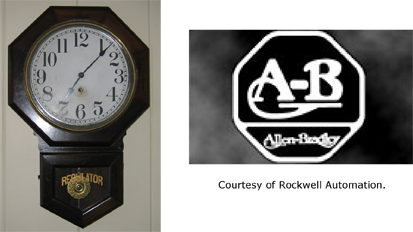current in automobiles…”
The device was called the Bradleystat, a clear play on “rheostat.” Soon, it found much greater application as a volume control for radios which were booming in popularity at the time. A commemorative published by Rockwell Automation upon reaching a century in 2003 noted:
“When the Bradleystat knob is turned, an equalizer spring exerts force on two columns of carbon disks, which vary the resistance—and radio volume—smoothly, without steps. By 1925 Radio Component sales account for nearly 50% of the company’s sales.”
On the crest of this unexpected wave of success, in 1923, the octagon trademark appeared for the first time. It was divided into two sections, the upper featured the letters A-B and the lower the name Allen-Bradley. Later, the word “quality” replaced the company name.
The upper and lower sections of the trademark are graphically similar to the upper and lower sections of the schoolhouse clock, whose face is surrounded by an octagon in the upper section and whose lower section features the word “Regulator” stenciled across the glass door in front of the pendulum compartment. Even the slightly curving line formed by the bases of the letters in the words Allen-Bradley is similar to the slight arc of the word Regulator.
The trademark doesn’t match the clock perfectly, but it certainly is close in form.
In addition to the commonality in terms of what the schoolhouse clock represented—precision and regulation—and the form match, clocks clearly were a major interest of the Bradleys.
Jerry Blackstone, manager of public relations for Rockwell Automation before he retired, in his introduction to a history of the company that was published in 1987 began:
“It’s likely that few industrial companies founded 80 years ago or more have as detailed a record of their history as Allen-Bradley. This can be credited largely to the interests of their founders Lynde and Harry Bradley (photography, history, and clocks
being among them) and their sense that what they were doing would be significant to a great many people for a long, long time.”
An Allen-Bradley retrospective about the current clock, published in 1982 on its twentieth anniversary, referred to “Harry Bradley, master tinkerer and lover of clocks.” Though already in failing health that Halloween eve in 1962, Harry threw the switch that lighted for the first time what Guinness proclaimed to be the largest four-sided clock in the world.
John Gurda’s book The Bradley Legacy: Lynde and Harry Bradley, Their Company, and Their Foundation posits that Harry intended the current clock to be, “…the village clock for Allen-Bradley’s home neighborhood.” Architect Fitzhugh Scott, Jr., who died in 1998, said, according to Gurda, “Harry wanted a clock that Allen-Bradley’s workers could read from their houses.”
Scott, Jr. created the look and scale of the clock, but the complex mechanisms that drive eight hands synchronously and have kept accurate time for more than 40 years, were engineered from a blank sheet by Ray Ellsworth, who was a designer in the special machinery engineering department of the company, beginning in 1960. Until Walter Freeburg, then the plant engineer, stopped at his desk and gave him the project in early 1962, he had never done anything involving clocks. He didn’t let that stop him.
“A clock is just a gearing situation and I had worked on many motors and machines in the shop,” he said. “This was the same sort of thing. It was a challenge because of its size."

Did the schoolhouse clock inspire the
Allen-Bradley logo?